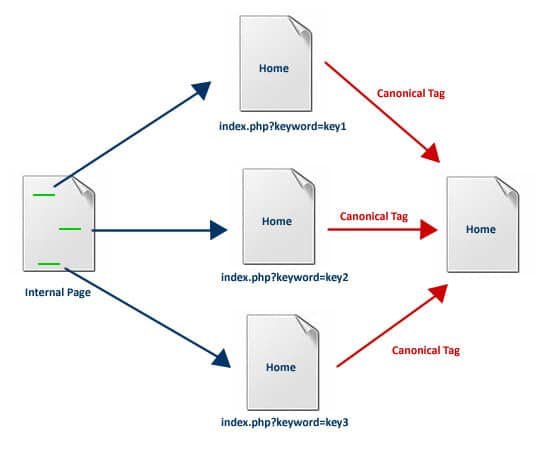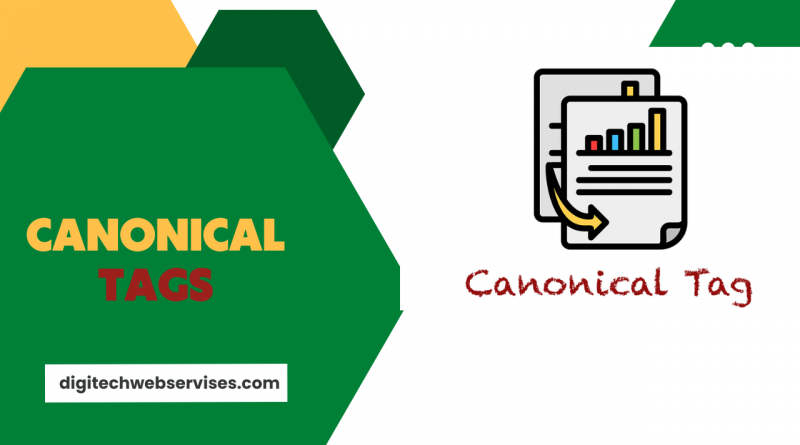Learn how to improve the positioning of your web pages with Canonical Tags
Canonical Tag is a mark inserted in the source code of web pages, indicating that it is original content. Search engines read this tag, which acts as a warning that this is the page the user should be redirected to when performing a search.
Classifying a web page well is a constant challenge that many SEO professionals dedicate themselves daily.
Although there is an understanding of what makes search engines find pages easier, you also need to know what can get in the way.
The canonical tag is an important mechanism that helps to correctly index these pages. Google’s algorithm seeks the greatest possible clarity when it detects web pages.
If they somehow discover that there is similarity between the addresses, you can interpret them as duplicate content , which makes ranking difficult . Canonical etiquette is a simple intervention that can help you avoid this problem.
To better understand the topic, in this content we will delve into what the canonical tag is about in topics such as:
- What is canonical tag?
- Why use the canonical tag?
- How does the canonical tag work?
- When and how to use the canonical tag?
- What is the importance of 301 redirect?
- How does canonical etiquette work for social media?
- What are the best practices for using this functionality?
- What are the most common canonical tag errors?
- What are the most frequently asked questions on the subject?
Keep reading and learn more!
What is a canonical tag?
Table of Contents
The canonical tag is a mark inserted in the code of the web pages to define that it is original content .
This tag serves directly to be read by search engine algorithms such as Google and Yahoo and serves as a warning that this is the page that users should be redirected to when searching these sites.
It is common to find the same pages, but with different URLs , all within the same site. These address variations often occur naturally in website construction, but they can be harmful when ranking the page.
The canonical tag shows the algorithm whose priority is the original page that will be shown in the search results.
Why use the canonical tag?
One of the big problems a web page can have when it comes to ranking is being in a potential duplicate content situation . In practice, these are just address variations, but they are found in different URLs. In general, it is something like:
- “Site-address”;
- “Site-address / index.html”;
- “Site-address / home.aspx”.
If you’re looking at the URLs on the page, you’ve certainly noticed these variations, but you’ve also seen that they lead to the same place. However, this can be a problem for search engine algorithms .
In the end, for them, the same content in different directions represents duplication of pages, which leads to penalization and, consequently, the loss of positions on the results pages.
To solve that, it’s simple: just use the canonical tag on the original page . Therefore, it will be shown in the results as the main one without flowing to the other direction.
The use of the tag is essential to preserve the ranking of the pages that are important for a Content Marketing strategy or Digital Marketing in general.
Google’s actions on positioning
Recently, Google has been working to prevent sites from using unhealthy practices for high ranking with different pages that have the same content.
For that, the algorithms went through updates that allowed them to detect when this duplication exists . In this scenario, of course, there are many companies that do not intentionally use this possibility, but will invariably be penalized for their classification.
Thus, it is essential that SEO professionals carry out verification work constantly. This avoids inadvertent duplication and makes the canonical tag be used in a better way.
How does the canonical tag work?

In essence, you use the canonical tag in the same way as a 301 redirect , where you tell the algorithm to go to another page. However, the canonical tag works only for search engines , allowing you to attract visitors to that page.
With the canonical tag you do not allow pages with URL variation to be indexed, but the user to access them. If you use a 301 redirect, you will also not allow access from one or the other.
In this way, the canonical tag works as a way to optimize your SEO without damaging the use experience of your visitors.
When and how to use the canonical tag?
When search engines don’t identify which version of your content should be included or excluded from indexing , or when they don’t know which page should guide metrics like trust and authority, now is the time to use the canonical tag.
Of course, this confusion over original content often reduces your ranking relevance . SEO professionals know the damage that this behavior brings, so it is essential to always be aware of the different pages and the access metrics they receive.
If your site creates multiple pages for the same content, the canonical tag should be used . Most of the time, this replication of different addresses is generated by printed pages or even pages where only some URL parameters are changed.
Applying the canonical tag
First, the canonical domain is defined, that is, the search site – Google, Bing , Yahoo !, among others – will be informed that a particular URL is the preferred indexing page for your site.
It is important to remember that you must choose between the version with or without “www.” And then when indexed this domain will be used in search results as well as future crawls and page updates.
Its application is quite simple: it only uses the references “rel” and “href” . Suppose the preferred URL is the “site-address / institutional” address .
So for that to be suitable for search engine bots you need to add a <link> element to the head section of the pages:
<link rel = “canonical” href = “site-address / institutional” />.

When that activation occurs, it is certain that most users will come across that URL in every search result the page appears on.
What is the importance of 301 redirect?
Practice ensures that traffic, as well as the search engines themselves, are directed to the correct destination. Code 301 will make those engines understand that the page has been moved to another location instead of detecting it as duplicate pages .
It is also recommended to use 301 redirect when you intend to redirect visitors from one domain to another .
This need can occur when a company changes its name and, with the intention of preserving its customers and followers as much as possible, it seeks to accustom them to the changes instead of migrating entirely.
In this case, you need to make sure that each of the old URLs leads to the new domain on the respective pages where each new version of the content is located.
To be effective in those changes, there are some other important points to keep in mind, such as:
- keep Google informed of changes at all times, so if you migrate to a new domain, you can change your address in your site settings through Google Webmaster Tools ;
- make sure Googlebot crawls the new domain;
- ensures that old URLs are not blocked, otherwise they will avoid redirection ;
- Be aware if visitors encounter the 404 error , although it is best to prevent the problem from occurring. A tip to help with this task, is to do the tests yourself, list all the URLs and access them through Quick URL Opener . When it detects URLs that have errors , it tries to correct the problem as soon as possible.
How does the canonical tag work for social networks?
This variation of URLs can also occur on social networks , however, there is a behavior that generates questions from users related to the likes of Facebook and Twitter.
When there is more than one address for the same page on those platforms, the likes count will only appear in the URL tagged with the tag . Thus, the user cannot see his like posted on the page he visits.
What are the best practices for using the tag?
In this job of applying canonical tags, the ideal is to implement a qualified work parameter that avoids Google penalties. Thus, there are some good practices that should always be ahead of the company’s SEO work. Check it!
Use lowercase letters in URLs
Since Google can treat uppercase and lowercase URLs as two different URLs, pay attention to using lowercase letters on the server and then do the same in the address of your tags.
Use the correct domain version (HTTPS or HTTP)
If you switched to SSL , no longer use any URL other than “HTTPS” in your canonical tags. Doing it theoretically can lead to confusion and unexpected results. The same goes for the opposite: if you don’t have an SSL certificate, use only “HTTP” .
Use only one canonical tag per page
This is simple: if you use more than one canonical tag per page, Google ignores both and you continue with the ranking problem.
What are the most common canonical tag errors?
When inexperienced people start applying canonical tags, it’s very easy to fall into a series of misconceptions that can completely harm traffic . Therefore, it is essential to obtain as much information as possible before taking action.
Ideally, follow the recommendations of the search engines themselves that adhere to those tags or true experts in the field, in this case, experienced webmasters.
To avoid risks, check below for some mistakes that can be avoided from the beginning, ensuring a good experience with canonical labels.
Not understanding that canonical tags exist for one purpose only
Much of the trouble beginners experience comes from forgetting one important detail: the strategy only serves to avoid duplicate content and nothing else!
With that in mind, avoid using canonical tags for any purpose other than solving duplicate content problems, as the chances of generating new problems are very high.
Apply rel = canonical to wrong locations
For the technique to work, rel = canonical must be located in the <head> section . Otherwise, if the code is entered in the <body> section, for example, search engines simply ignore the reference.
In addition to rendering the technique unusable, this can compromise the HTML structure of the page.
Not checking the source code carefully
More common than creating ready-made code templates to declare rel = canonical, in order to speed up work is to copy it without making any changes to the destination link . It is like redirecting the user to an incorrect page and testing the reputation of the site as a whole.
Using SEO plugins can also lead to problems of the same nature, such as including two or more canonical statements in the same source code and, in addition to where the reference is outside the main section, search engines will also ignore your application .
Using canonical tags on unduplicated pages
As we have explained in the first common mistake, the technique should only be applied to duplicate content . An example that is becoming classic is the use of canonical in articles that extend to other pages, making all pages refer to the first page.
That way, all content on pages after the first page will be lost precisely because it is not duplicated. In this case, it is recommended to use the canonical tag to get a complete view of all content – all pages.
What are the most frequently asked questions?
Finally, we’ve put together a real FAQ on the most common questions that SEO professionals and inexperienced people have when dealing with canonical tags. Check out the main ones below!
Is the canonical tag approved on PageRank?
Yes, according to Google, you decide the URL of the tag to consolidate this link to similar or duplicate pages. Search engines can obtain more specific information for URLs.
Ultimately, it’s up to Google to decide how your URLs will be treated, but in general, when the search engine respects your canonical tags, PageRank is approved.
Why does Google ignore some tags?
This happens when the algorithm does not trust the precision of the given label . In this case, there is the skip behavior, but only on the understanding that the content between pages is not so similar.
Are the canonical tags weaker than the 301 redirect?
It turns out that the tags are hints, while the redirect is final. Google understands it exactly that way, so canonical tags are sometimes perceived to be less effective.
Do canonical tags only work on duplicate pages or can they also be used on similar content?
Only for duplicate pages or with very similar content. Otherwise, as we’ve already exchanged, Google will ignore the request for the tag.
What types of pages can receive a canonical tag for a different URL?
These are:
- multiple versions of a page to support different types of devices. For example, “site-address / news /” and “site-address / news /”;
- parameters and session IDs . For example, “site-address / products? Category = dresses & color = green” or “site-address / dresses / cocktail? Gclid = ABCD”;
- a single page present in multiple category subfolders . For example, “site-address / decor / pillows” and “site-address / bed / pillows”.
The use of canonical tag can be a critical feature to ensure that sites are classified correctly without being harmed by Google’s algorithm. This guarantees effectiveness in SEO parameters and helps, for example, to strengthen Content Marketing strategies.
With this in mind, you must learn what to do when it comes to SEO, check out our ebook on SEO best practices !



